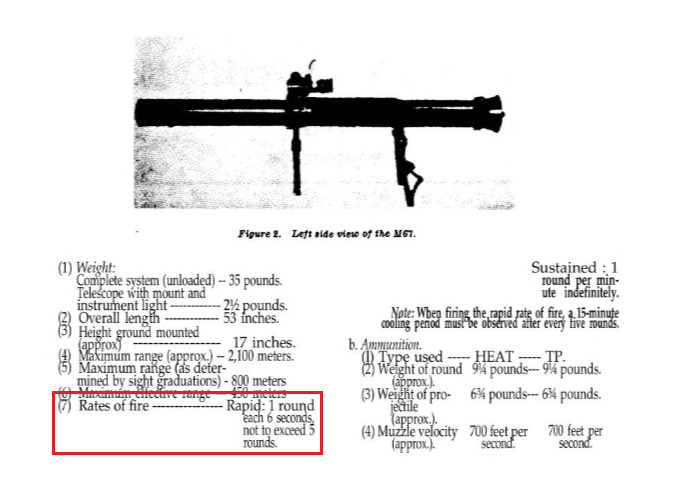- Yes
- No
Overview
This suggestion is intended to represent a British Army FV432 Mk.2 armoured personnel carrier mounting the L14A1 recoilless rifle. From adoption in 1962 to its end of use in the early 1990s, the L14A1 was used by the mechanised and airborne infantry for close-range destruction of enemy armoured vehicles (and also by the Royal Marines as an anti-ship weapon).
Fig.1 12EA12, an FV432 Mk.2/1 with the L14A1 fitted on a rail-mounted pintle above the mortar hatch, the standard fitting for the weapon when fired from the vehicle. This vehicle is equipped with the front-mounted buoyancy trimmer, for use with flotation screens. 12EA12 was later converted to carry the Field Artillery Computer Equipment (FACE), and served with the Royal Artillery.
The Weapon
Accepted for service by the British Army in 1962 as the GUN, 84mm, INF, ATK, L14A1 and colloquially named the “Charlie G”, the L14A1 was the British variant of the Swedish M2 Carl Gustaf anti-tank recoilless rifle. It replaced the M20 Mk2 ‘Super Bazooka’ in British service, supplementing the heavier RCL and WOMBAT recoilless rifles.
The L14A1 was equipped with either iron sights or the No.78 Mk1 Sighting Telescope - a 2x ocular sight - and was regarded as being accurate against moving targets up to around 400 metres, and static targets up to 500 metres. In British service it only fired the L40A3 84mm HEAT round, which was capable of defeating 400mm of RHAe. Other ammunition types such as HE, Smoke, and Illumination rounds were considered, but never entered service.
Carried at Section level, the L14A1 provided an organic anti-tank capability to the British infantry of the mid-to-late Cold War. It could be used by a dismounted anti-tank team, or fitted to a purpose-built pintle-and-rail system fitted above the FV432 mortar hatch for mounted fire from a stable, armoured platform. Deployment of the L14A1 declined after the introduction of the MILAN anti-tank missile in 1978, and after service in the Falklands it finally left British service in the early 1990s.

Fig.2 The L14A1 on the range, the No.78 Mk1 sight and L40A3 HEAT round are visible.
The Wagon
Entering service in with the Mark 1 in 1963, the FV432 has sustained a lengthy career all the way to the present day (it’s said that the British Army will be fighting on Mars in the FV432 in the year 2157). Built by GKN Sankey at Hadley Castle Works, Telford between 1963 and 1971, the FV430 series consists of the the FV432 armoured personnel carrier and its specialist variants for tasks from anti-tank (FV438 Swingfire), recovery, repair, medical, command, artillery, and others.
This highly successful vehicle has remained in service for over 60 years in part due to its simplicity and reliability, and the failure of almost every attempt to replace it. The variant found in this suggestion is the FV432 Mk.2, introduced in 1965.
Ammunition Stowage
The rear compartment space of the FV432 Mk.2 is prodigious when carrying only a two-man anti-tank team, in comparison to its normal capacity of a full eight-man infantry Section. Ammunition stowage for the L40A3 84mm HEAT, which is provided in six-round steel ammunition crates, is comparatively simple, with 4-5 crates easily stored on the floor of the compartment to give a magazine of 24-30 rounds. Additional ammunition stowage could be achieved through use of the redundant seating positions or panniers.

Fig.3 Interior view of the troop compartment.

Fig.4 The six-round L224A1 ammunition box for L40A3 84mm HEAT ammunition.
Specifications - L14A1
Calibre: 84mm
Length: 1,123mm
Weight: 15.87kg
Rate of Fire: 6 rpm
Effective Range (HEAT):
- Stationary Target: 0 to 500m
- Moving Target: 350 to 400m
Specifications - L40A3
Caliber: 84×245mmR RCL
Projectile Mass: 2.55kg
Muzzle Velocity: 255m/s
Explosive Type: RDX/TNT (60/40)
Explosive Mass: 550g
Specifications - FV432 Mk.2
Length: 5.20m
Width: 3.02m
Height: 1.88m
Weight: 13,895kg
Crew: 4 (CMDR, DVR, GNR, LDR)
Armour: 12 / 12 / 10mm RHA
Engine: Rolls-Royce K60 Mk4F (240hp @ 2,400rpm)
Transmission: GM-Allison TX-200-4A (6 Forward, 1 Reverse)
Speed: 52km/h
Armament:
1x L14A1 84mm Recoilless Rifle
1x L7A2 7.62mm General Purpose Machine Gun
2x No.8 Multi-Barrel Smoke Grenade Dischargers
Ammunition
Round, 84mm Inf, HEAT, L40A3, Fused L42, Tracered (estimated 24 rounds minimum)
Round, 7.62mm Ball, L2A4 (1,600 rounds in 8 200-round belts)
Smoke, Screening, L8A1 (6 rounds loaded in SGDs)
Sights
Commander: 3x AFV No.32 Mk1 (x1), in a 360-degree cupola.
Driver: AFV No.33 Mk1 (x1), Periscope Armoured Vehicle Image Intensified, L5A1 [NV1]
Summary
In War Thunder, the FV432 Mk.2 (L14A1) would be a played as a light tank destroyer with medium mobility and good single-shot firepower. It should be placed with similar vehicles (lightly-armoured recoilless rifle carriers) at BR 6.7, where it can effectively engage its intended target; the steel-armoured tanks of the mid Cold War.
Videos
Sources
AESP 2350-T-253: CARRIER PERSONNEL FULL TRACKED FV432 MK2 & MK2/1 (BOWMAN), 2004
HB 64/1 USER HANDBOOK for the GUN, 84mm, INF, ATK, L14A1, 1968
USER HANDBOOK (PROVISIONAL) FOR THE LAUNCHER, ROCKET, 3.5 INCH U.K. M20, MK2, 1952
Profile AFV Weapons 53 - The FV432 Series, Christopher Foss, 1973
Jane’s World Armoured Fighting Vehicles, 1976
Танки и танковые войска (Tank and Tank Troops, English translation), 1982
The Tank Museum - Carl Gustaf
Paradata - Carl Gustav Anti Tank Weapon
Crusader80 - ANTI-ARMOUR





